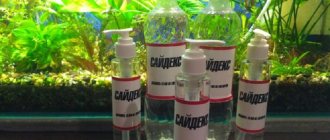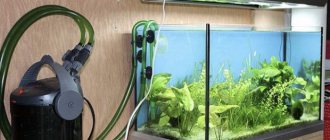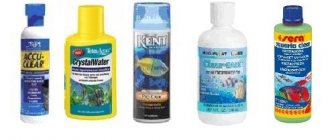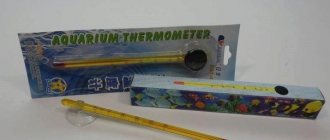An electric water heater for an aquarium is designed to maintain the temperature background necessary for the growth of plants and animals.
The equipment can be installed both inside and outside the tank; there are factory-made devices and home-made installations.
Water heater for heating water in an aquarium.
Reasons and need for use
The air temperature in the room reaches +26°...+28°C in the summer and drops to +20°C the rest of the time (with the heating turned off or not working correctly).
Summer values do not have a negative impact on tropical fish and plants in aquariums, but when the temperature drops, a water heating system in the aquarium is required.
Otherwise, the risk of partial or complete loss of flora and fauna in the reservoir increases. Heating ensures not only maintaining a stable temperature, but also convection mixing of water layers.
Video
Aquarium heaters: what they are and how to install them correctly
How to choose an Aquael heater for an aquarium
HEATERS FOR AQUARIUM FROM TM LAGUNA!
#120 HEATERS IN AQUARIUM. TYPES, DEVICE AND POWER CALCULATION. Heaters in the aquarium
Water heater device
A classic immersion heater consists of an outer glass flask of an oblong configuration with sealed plugs. Inside there is a nichrome spiral wound on a metal core through a layer of insulator.
When voltage is applied, the coil and core heat up, thermal energy is transferred to the body, and then increases the temperature of the water.
To regulate operation, a sensor is used that determines the degree of heating of the liquid and automatically turns the power on or off, reducing the risk of overheating and fire of the equipment.
Thermostat and its types
Devices for setting temperature conditions are divided into categories:
- With a mechanical operating principle, they are characterized by simple design and reduced cost. Due to the use of contacts, they do not provide high accuracy of adjustment (the error is up to 3°C); it is recommended to install a thermometer to check the temperature of the liquid.
- Electronic, equipped with an information display. The equipment is characterized by increased adjustment accuracy, but high price and average reliability limit its distribution.
Regardless of the type of measuring unit, regulators are divided into remote and built-in.
External devices are installed on the wall of the aquarium; the absence of exposure to water and waste products of fish and plants allows you to increase the resource, but it is necessary to pre-mount a temperature sensor with a switching wiring harness in the tank.
Built-in products are located in a single heater housing, which eliminates unnecessary cables and reduces the size of the water heating system.
Electronic water heater with display.
Aquarium thermostats
These are devices with a built-in thermostat. You set the required water temperature, and the device heats it up to the required numbers. After this, it automatically turns off, turning on after the medium begins to cool.
There are 2 types of such water heating devices.
- Mechanical.
- Electronic.
Important! Mechanical devices are less accurate (the error is from 1 to 2 degrees), but have a lower cost. Electronic devices are much more accurate, but their cost is much higher.
Most devices come without a built-in thermometer. The device maintains the optimal temperature, but does not display its value. Therefore, you need to purchase a special thermometer for water along with the thermostat.
When choosing an aquarium water heater, you need to pay attention to the following characteristics:
- Correct selection of power.
- The presence of thermoregulation.
Important! It is believed that a 10 W device is enough to heat 4.5 liters of water. For an artificial reservoir of larger volume, it is better to buy not one powerful device, but several low-power ones: this way it is easier to heat the water to optimal levels.
Advantages
Modern models of water heating devices have the following advantages:
- Reliability.
- Possibility of placement under water.
- Safety.
Important! During prolonged use, the device may produce errors, so it must be checked periodically using a regular thermometer.
Now about which water heater for an aquarium is better. If you are using shallow soil, it is advisable to use a thermal cable heater. In this case, you not only maintain the necessary environmental characteristics, but also create better conditions for aquatic plants. In addition, heated water freely rises to the surface without stagnating in the ground.
Types of aquarium heaters
To heat aquariums, several types of heaters are used, differing in design and installation method:
- for external mounting, mounted under the base of the aquarium or in the external filter housing;
- with a location in the water column, there are products with bodies made of different materials;
- flow type, heating the flow of water passing through the block;
- bottom, which are heating cables hidden in the thickness of stones or soil.
External
The external heater is located inside the filter housing, installed outside the aquarium body. The water is purified from foreign impurities and at the same time heated to a preset temperature (the design includes a sensor for automatic power control).
There are designs in the form of a rubber or plastic platform with nichrome threads located inside, on which the container is placed.
The disadvantage of the design is low efficiency; most of the thermal energy is dissipated and spent on heating the glass base of the aquarium.
External type of water heater.
Submersible
Immersion-type products are divided into categories based on body material:
- Made of heat-resistant glass, resistant to external mechanical influences. The device is adjusted to the required liquid temperature, the power is turned on and off automatically (provided the plug is installed in the outlet).
- Made from impact-resistant plastic that can withstand heat. They are characterized by reduced dimensions and reduced weight, and have improved sealing of the internal cavity of the casing. The circuit includes a sensor to maintain the set temperature.
- Made of titanium, designed for heating liquid in large-volume aquariums (for example, for breeding large marine or freshwater fish or turtles).
- Small-sized devices with a flat body made of heat-resistant plastic, designed for installation on the surface or in the thickness of the soil. They are distinguished by reduced power, designed for tanks with a volume of up to 50 liters.
Submersible water heater.
Flow-through
Flow-type equipment consists of a housing with a heating element and a channel through which water passes. The power supply is turned on automatically when the movement of the liquid is detected, which is pumped by a small-sized rotary pump.
The disadvantage of the products is the increased energy consumption of the heating coil; some owners criticize the equipment for the extraneous high-frequency noise of the pump motor.
Instantaneous water heater for an aquarium.
Donny
Bottom-type products are located in the ground and provide convection circulation of layers of water having different temperatures.
The equipment allows you to heat the lower layers of the liquid, but for full heating it is recommended to install an additional flow-through or immersion type unit. The disadvantages of the design are increased energy consumption and the inability to work in fine sand.
Bottom heater for an aquarium.
Briefly about the purpose
The water in the aquarium can cool down in a few minutes. This is especially true for the cold season, when the temperature of residential premises depends on the weather and the conscientiousness of the stokers.
There are many more factors that affect temperature that a novice aquarist may not even be aware of. For example:
- heat from lighting fixtures and the distance of the container from them;
- design: shape, volume, is there a lid, a gasket under the container, the presence of an internal volumetric background, is it located on a stand;
- is there a flow system from the water supply;
- number of water changes.
Therefore, you cannot do without heating the water in the aquarium. Heaters are used for this purpose.
Aquarium heaters are divided into three types based on location.
1. Remote. Their advantages:
- are not contaminated by waste products of the inhabitants;
- increased service life;
- relatively cheap.
2. Containers built directly into the body, complete with heating element.
3. Submersibles look like a cylinder that is lowered into the water. The body is made from:
- plastics;
- glass;
- titanium.
And now more about each type of water heater in an aquarium.
Heaters
The simplest device is a water heater in an aquarium without a thermostat. It is a glass or metal tube with a nichrome thread soldered inside. According to the principle of operation, it vaguely resembles the well-known boiler. In Soviet times, during the era of total shortages, it was the boiler that was used as a replacement for the heater. Even now, experienced fish lovers do not disdain this primitive device - in a hopeless situation, of course.
You need to very clearly grasp the moment when the boiler needs to be removed, so as not to end up with fish soup made from precious fish. Some craftsmen connect a boiler with temperature sensors. However, the modern aquarium equipment market provides a lot of options for providing such indicators as temperature.
Electromechanical thermostats
An improved mechanical heater is a metal or glass tube filled with a heater and thermostat, hermetically sealed. The thermostat is a bimetallic plate. The property of metals to expand when heated ensures automatic switching on and off.
This device is reliable in operation, but sometimes distorts the indicators. To prevent troubles, measure the water temperature with a regular thermometer.
Electronic thermostats
It looks like a tube. Inside there is an electronic “filling” that provides functions. Such a thermostat has capabilities that Soviet aquarists could see only in a dream or in Western European specialty stores, if they managed to get abroad.
The advantages include:
- high accuracy (up to 0.1°C);
- presence of an electronic scoreboard;
- sound alarm when overheating.
Flaws:
Heating cables
They are a long elastic tube with a heating element, which is installed in the soil of the container.
Advantages:
- the entire mass of water is heated evenly;
- additional circulation is created;
- the aesthetic component wins;
- very useful for plants planted in an aquarium.
Flaws:
- when replacing faulty cables, you have to disturb the entire interior;
- The ecosystem design has limitations - heavy stones cannot be used, which can squeeze or damage the heating system.
Heating mats
Rugs, or heating mats, are placed under the container. The principle of operation is the same as that of heated floors, water mattresses, and heating pads.
Advantages:
- water and soil are evenly heated from below, which is extremely beneficial for plants;
- cold layers do not stagnate at the bottom, the environment in the entire aquarium is the same temperature.
The disadvantages include the inconvenience of installation and replacement - you have to remove the aquarium. If it is big, then it becomes clear that this is a whole undertaking that cannot be done without help.
Pros and cons of the device
Advantages of electric heaters:
- maintaining the required water temperature;
- the presence of a heating intensity control system;
- ease of installation and operation.
Equipment disadvantages:
- the need to manually configure equipment due to daily changes in ambient temperature;
- the risk of overheating of the liquid in the aquarium due to breakdown or malfunction of the regulator;
- In the event of a short circuit, the death of the inhabitants of the aquarium is possible.
What information will you find in the instructions for use for the water heater?
In addition to the technical characteristics of the device, which can be found in the instructions for use for the water heater, it is worth considering the recommendations for installing and adjusting the device. When you purchase a water heater for an aquarium, how to install it correctly will be described in the instructions. There you can find the following recommendations: The device can be completely immersed in water as it is waterproof. Do not install the heater in gravel or sand. Don't forget also about the decrease in water level due to evaporation. The water heater must be fixed in a place where constant and uniform circulation of water is ensured. Pay special attention to the following point: only 15 minutes after lowering the device into the water can you connect it to the network.
Recommendations for adjustment are as follows: you need to wait until the heater warms up a little - to the temperature of the surrounding water. Only after this should it be turned on. When the indicator light is on, it means that the device is turned on. Further recommendations will be different depending on the presence or absence of automatic adjustment. Read the instructions before installing the device. Important recommendations for a particular model will be indicated there.
Calculation of parameters for a specific aquarium
For the calculation, a table is used that takes into account the capacity of the tank and the difference in temperature between the water and the environment. In large aquariums (with a capacity of more than 100 liters), it is necessary to install 2 or more heaters.
To measure the temperature of the liquid, use a mercury, alcohol or electronic thermometer located in the lower layers of water. Below is an example of a table suitable for calculations.
The operator on duty at the KVANTA + online store will help you determine the parameters and choose the appropriate heater model.
| Temperature difference, °C/volume, l | 2 | 6 | 10 |
| 20 | 5 | 17 | 28 |
| 60 | 12 | 35 | 58 |
| 100 | 17 | 48 | 80 |
Installation and rules of use
The device must be mounted on suction cups on the lower part of the rear wall of the tank; the body is installed horizontally to improve convection mixing of the water layers.
If the aquarium has a filter, then it is necessary to direct the outlet pipe to the heating element, which improves the quality of heating the liquid throughout the entire volume. Before testing, rinse the housing with running water and place it in the aquarium to equalize the temperatures.
It is recommended to remove the fish from the tank, as a faulty device may cause an electric shock. Then you should set the required temperature and turn on the power (the test lasts up to 40 minutes).
If no malfunctions are detected, then the inhabitants can be launched back. During operation, the housing should be regularly cleaned of deposits (the frequency specified by the manufacturer in the instructions).
Installing a water heater in an aquarium.
Temperature adjustment
When setting, it is necessary to take into account the measurement error, which is 1°...2°С upwards. For example, instead of the required +28°C, they set +26°C, and then check the result with a thermometer.
The automatic sensor maintains the set value, but if the ambient temperature rises (for example, due to heating or direct sunlight), the water may overheat.
Reviews of different water heaters
And of course, anyone will look at reviews about the device before buying an aquarium water heater. The price will be taken into account, as well as the positive and negative aspects of the operation of a particular device. For example, here are some reviews about different models:
- Water heater for aquarium Xilong AT-700. Customers generally respond positively to this model, because it is quite powerful. The operating temperature of the device is from 20 to 30 degrees. There is manual adjustment, it is located on top. The way to attach the water heater to the aquarium is well thought out - there are suction cups. Perfect for 100 liters of water.
- Aquael Comfort Zone aquarium water heater. Users are satisfied with the operation of such a water heater. The only thing stopping you from buying is the fact that it is made using a solid body. Because of this, many problems arise during device repair.
Aquarium heater maintenance, repair
During operation, it is necessary to clean the surface of the heater from deposits that impair heat transfer and destroy the sealing collars.
Vinegar is used to treat glass products, and traces of salt can be wiped off with a soft brush. To remove deposits from plastic or elastomers, use ethyl or isopropyl alcohol.
Electrical components may be treated with special solutions that do not adversely affect performance.
Since the equipment has a sealed housing, repairing components is difficult. Owners can change elements located outside the instrument casing (for example, a temperature sensor or plug).
It is allowed to lengthen the power cables with subsequent insulation of the joint (the modified wiring must be outside the liquid layer).
Device selection criteria
When selecting a heater, take into account:
- power consumption, which should be in the range from 10 to 100 W (when calculating, take the parameter at the level of 0.7-1.0 W per 1 liter of water);
- the dimensions of the aquarium (for example, a submersible product must be completely under water);
- type of liquid in the container (sea water requires salt-resistant equipment);
- the presence of an emergency shutdown device (for example, a fuse that breaks the power circuit in the event of a short circuit);
- presence of smooth heating temperature control;
- quality of manufacture of the casing and electrical wiring (short circuit due to poor insulation leads to the death of animals in the aquarium and overload of the home network).
How to choose the right water heater for you?
Let's say you decide to buy a water heater for an aquarium. How to choose it? It’s worth thinking about this in advance so that when you come to the store you already know exactly what you want. You should pay attention to the length, which should correspond to the water level in the container. Domestic heaters are all the same in length. If you purchase a model without automatic adjustment, you will have to calculate the temperature so that the water does not overheat in hot weather. Or you can install two such devices and turn off one of them in summer weather.
There are two opinions regarding the advisability of using an automatic temperature controller. Some believe that the liquid should change its thermal regime at different times of the day, as in its natural environment. Automation cannot provide this. Others, on the contrary, are sure that the aquarium should have a constant temperature.
In order not to make a mistake with the power, it is better to choose a more powerful water heater for an aquarium, with automatic adjustment. This way you can set the heating to turn off when a certain temperature is reached. In this case, be sure to pay attention to the quality and, accordingly, to the manufacturer.
Popular models of aquarium heaters
The online store offers heaters from the following companies:
- Juwel Aquarium, which has been producing aquarium equipment for 50 years;
- Tetra, offering professional water purification and heating systems;
- Polish Aquael, which produces equipment for aquariums with a volume of 10 liters or more;
- JBL Pro Temp, which produces heaters for home and industrial use.
Juwel
The company offers digital thermometers and equipment in the Aqua Heat series with automatic control, having a power of 50, 100, 200 and 300 W.
The degree of heating can be adjusted, the body is made of laminated impact-resistant glass (meets the requirements of German safety standards TUV/GS). The manufacturer offers aquariums with a special compartment for installing a water heating system.
Devices from Juwel.
Tetra
Products of the TetraHT series with power from 25 W are supplied under the Tetra brand, characterized by improved housing sealing. The manufacturer allows long-term operation of the equipment in thick water without the risk of liquid leakage or short circuit.
There is a red control LED that operates when power is applied. An additional advantage is the extra long power cord with elastic, waterproof insulation.
The devices allow you to heat water up to +31°C; the kit includes suction cups for installation on the glass of the aquarium.
Tetra water heaters.
Аquael
The Aquael company offers heaters of the Ultra, Platinum Heater, Comfort Zone Fix and Gold series, which differ in design and performance characteristics.
The equipment is designed to heat water to a temperature of +33°C (adjustment accuracy - 0.4°C). The design uses ceramic radiators and built-in thermometers.
Water heaters of the Aquael brand.
JBL Pro Temp
The company offers a line of Pro Temp equipment with power up to 500 W (flow-through and standard types). An information display is provided, the adjustment step is 1°C, and the flow device kit includes adapters for installation on hoses.
Water heaters from JBL Pro Temp.
Top 3 best aquarium heater models
There are the most optimal heaters, which are often used by aquarists to increase the water temperature:
- Barbus Heater 009 50 W . The average price is 300 rubles. Manufactured by a Russian brand. Has a power of up to 300 W. For small aquariums, it is recommended to buy a 50 W unit. The elements are double insulated inside to prevent sudden breakdown or short circuit. The product with a metal case is equipped with a dial. Temperature adjustment is carried out within 20-32 degrees.
- Tetra HT . Approximate price 1300 rub. The device is completely submersible under water. Has precise thermoregulation. Designed for large aquariums of 150-250 liters. Power is 150 W. The temperature is maintained within 19-32 degrees. It is often used for fish that like warm environments.
- Hydor External Aquarium Heater ETH 200-12 . Approximate price 4200 rub. The model is intended for experienced aquarists. Used for breeding large numbers of fish that require precise temperature control. It is maintained within 18-34 degrees. The power is 200 W, which is enough for a 200 liter aquarium.
DIY aquarium heater
To make a structure with your own hands you need:
- Calculate power based on tabular data taking into account the difference in water and air temperatures in the room. Based on the obtained value, it is necessary to calculate the current in the power circuit, and then determine the nominal resistance of the spiral.
- Connect the resistors in a series circuit and install the parts in a glass tube of a suitable size (recommended length margin is 150 mm).
- Fill the internal volume with sand, install rubber plugs on the sealant to prevent water leakage.
- Solder the power cable to the terminals (laid through the plugs); it is recommended to place the connection points above the water level.
- Place the product in water to check the tightness, and then connect the temperature controller with an external sensor and perform a test run.
The homemade product is installed inside the aquarium on suction cups or in a separate plastic tray. The design ensures temperature maintenance in tanks with a volume of up to 100 liters; for larger tanks it is recommended to use factory heaters.
The disadvantage of handicraft products is the low tightness of the wire entry points through the rubber plugs.
How to calculate power
The larger the volume of the tank, the more powerful the heater it will require. That is, if the capacity is 100 liters, then you need at least a 100 W heater. In general, we calculate 1 watt per liter. For example, an aquarium with a capacity of 200 liters will need a heater with a power of 200-300 watts.
It is worth considering that the lower the temperature in the room with the aquarium, the faster the heat leaves the tank. Domestic ponds with large lateral areas are most susceptible to rapid cooling. Therefore, it is recommended to purchase a heater with a slightly higher power of 2 Watts per 1 liter. This will help quickly correct a sharp drop in temperature in the aquatic environment. But at the same time, a heater with a strong power level must be of high quality. It will also be necessary to take into account the reliability of the device. To do this, you need to check the quality of the thermostat and heating element. After all, if a high-power heater malfunctions for some reason, the inhabitants of the reservoir will get sick and die either from a sharp drop in temperature or from severe overheating of the water.
It is important to remember that the power level of the device does not in any way affect the price or its electricity consumption.










